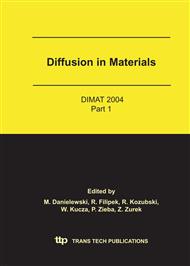p.940
p.946
p.952
p.958
p.965
p.971
p.979
p.985
p.993
Prediction of the Depletion Zone due to Selective Oxidation of P91 Steel
Abstract:
Experimental measurements do not allow for a unique determination of the concentration profiles, e.g., in case of multi-layer systems. The measured concentration of the elements at the alloy/scale interface is an average concentration in an alloy and in a scale near the spot of the beam [1]. The knowledge of the concentration of the elements at the boundary is necessary for the understanding corrosion of alloys. This essential obstacle of experimental techniques can be overcome by computer modelling. Namely, by combining the different methods (non-unique measurement with unique modelling). The Danielewski-Holly model of interdiffusion has a unique solution. This model enables to predict the evolution of component distributions in the reacting alloy. The model is valid for time dependent boundary conditions and consequently can be used for modelling the more complex reactions, eg., the formation of complex oxides. To avoid the nonphysical values of fluxes in reacting alloy the kinetic constraint on all fluxes was introduced, i.e., the flux limitation method. The results of the selective oxidation of the P91 steel (0,1 wt.% C, 8,6 wt.% Cr, 0,25 wt.% Ni) are presented. Calculated concentration profiles are compared with the experimental data. We show the evolution of chromium distribution in oxidizing steel up to 3 000 hours. The computations demonstrate that chromium depletion is the key factor determining the scale composition.
Info:
Periodical:
Pages:
965-970
Citation:
Online since:
April 2005
Authors:
Keywords:
Price:
Сopyright:
© 2005 Trans Tech Publications Ltd. All Rights Reserved
Share:
Citation:


